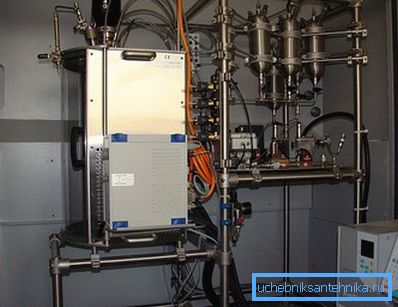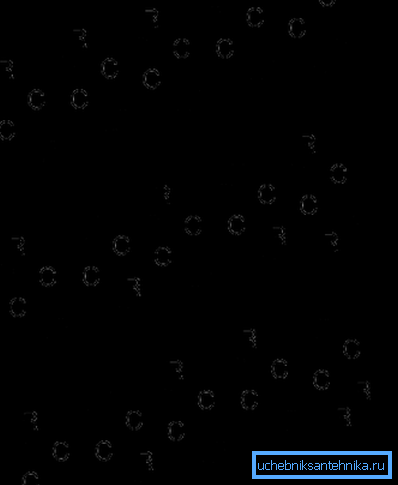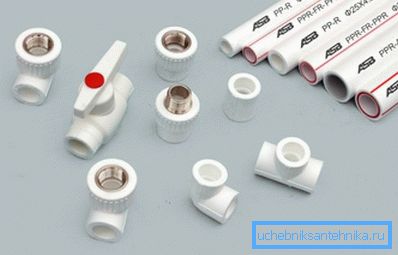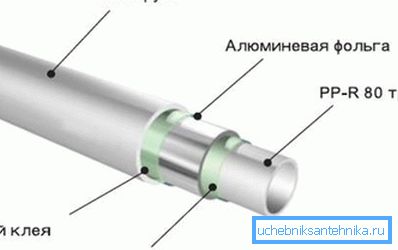Polypropylene pipes for heating: technical characteristics,
Despite the fact that Russia belongs to countries with an insignificant share of polypropylene consumption (1.6% of the world), from 2002 to 2012 its use increased from 250 thousand tons to 880 thousand tons, which tells us about the rapidly growing popularity of the material in the domestic market. In this regard, we want to consider the main technical and operational characteristics of polypropylene in relation to heating systems.

Polypropylene pipes
Raw material

To understand what properties are inherent in products made of polypropylene (PP), you should consider the main characteristics and characteristics of the feedstock.
The raw material for the production of polypropylene pipes is, of course, polypropylene (PP). This material belongs to thermoplastic polymers, which are obtained by polymerization of propene in the presence of catalysts of the metal complex group (TiCl4, AlR3). Depending on the catalyst used, various types of polymers and their mixtures can be achieved, the conditions for obtaining PP are similar to the conditions for the synthesis of low-pressure polyethylene.

As a result of the synthesis, three main types of the molecular structure of a substance can be obtained:
- Atactic PP is characterized by high fluidity, low density - about 850 kg / m3, low melting point - about 80 ° С, and solubility in diethyl ether. The structure of the molecule is distributed randomly. Used for the manufacture of adhesives, mastic, adhesive films, etc .;
- Isotactic PP has a higher density - about 910 kg / m3, high modulus of elasticity, high melting point - up to 170 ° C and pronounced chemical inertness to organic solvents, alkalis and acids. The structure of the molecule is such that all CH3 radicals are located on one side of the carbon chain. This kind of PP is used for the manufacture of containers, water pipes, various parts, fittings, fibers and threads;
- Syndiotactic PP in many respects repeats the properties of isotactic, however, here the CH3 and H groups are alternately arranged on one or the other side of the chain. It is obtained in the same way as isotactic, while the result of the synthesis is unpredictable: the result is a material containing different fractions in the structure.

Note! The price of polypropylene is quite low compared with the cost of competitive materials - steel, iron or other metals. Manufacturing products is also much less expensive than casting or rolling steel.
In addition to the three listed types of polymeric propylene, there are a number of its copolymers. We will not go into the subtleties of chemical science and list them all, but we’ll dwell on one such copolymer. This is the so-called statistical copolymer of polypropylene (PPRandomCopolymer or PPRC).

This material is obtained by adding a small amount of ethylene to the chain of the molecule, which does not violate its crystalline structure, but increases the impact strength and lowers the glass transition temperature.

Note! Physical and chemical properties of PPRC allow using this material not only for the manufacture of packaging and heat insulation, but also for the production of pipes for hot water supply and heating, as well as fittings for them. Today this material is the main raw material for the production of parts for heating and water supply systems.
PPR pipe specifications

We now turn to the consideration of a specific product from PP - water pipes. From this polymer make cold and hot water pipes, suitable for the transportation of both drinking and industrial water. Also increasingly use heating pipes for systems in which the coolant temperature does not exceed 90 - 105 degrees.
The pipeline of polypropylene parts is highly reliable due to the unique qualities of the material, among which are such features:
- Plastic is absolutely not susceptible to corrosion due to contact with water and other media, including aggressive. The inertness of the material allows it to serve for decades without loss of quality;
- The surface of the pipes is such that no silt or lime, salt and other deposits occur on it, which narrow the lumen of the channel;
- The density of the polymer is 910 kg / m3, which is the minimum among plastics. Due to the low density of the pipeline is easy, which significantly reduces transport and storage costs and simplifies installation;
- The maximum operating temperature of polypropylene is 110 degrees.. This makes it possible to use the material in virtually all climatic zones of Russia, since such increases in the coolant temperature occur only during extreme frosts;
- The material is elastic, which allows pipes to withstand the freezing of water inside their channels. Also this property allows better withstanding hydraulic shocks;
- Low thermal conductivity of plastic protects the surface of the pipe from condensation;
- High noise absorption coefficient makes plumbing almost inaudible.

The temperature range of use of propylene pipes is from -10 to +110 ° C. This is quite enough for the majority of engineering tasks to ensure water supply and heating of residential, administrative, and industrial buildings.

Note! The material has a significant coefficient of thermal expansion, which must be considered when designing and installing a pipeline.
Also one of the features of PP-pipes is the system of plastic reinforcement with fiberglass or aluminum foil. In the first case, glass fibers are integrated between the layers of polypropylene, in the second - foil is glued. Reinforcement increases the strength of pipes and the ability to withstand high pressures, and also significantly reduces the coefficient of thermal expansion.

Note! For heating systems with central feed or autonomous systems with hot coolant (not higher than 90 - 110 ° C), reinforced pipes made of PPR randomized polypropylene copolymer are best suited.
Also to overcome the effects of expansion of the material during installation provide annular compensators and other ways of leveling. On the other hand, plasticity allows the products to exhibit good toughness and flexibility.
Species

If we talk about the types of pipes made of polypropylene, then there are several:
- PN-10 in the marking means that the product is designed for a nominal pressure of 10 atmospheres (1 MPa) and can be used for installation of a cold water supply pipeline or heating systems with a coolant temperature not higher than 45 degrees. It is the cheapest and fragile appearance;
- PN-16 tells us about a nominal pressure of 16 atmospheres and a temperature no higher than 60 degrees. The scope of use is the same as in the previous species, only this class is more reliable and durable;
- Marking PN-20 indicates a pressure of 20 atmospheres and a maximum temperature of 95 degrees. It can be used in systems of heat supply and heating;
- If we have the abbreviation PN-25 in front of us, then we see the strongest variety of pipes in which reinforcement is necessarily present. The products withstand a pressure of 25 atmospheres and a short-term rise in temperature up to 110 degrees and appear to be quite reliable.

Also products may vary by reinforcement. The quality and cost of the aluminum system does not differ from those in fiberglass structures, but the welding of products with fibers is easier, especially for working with your own hands.

Note! For centralized heating systems, it is better to use only a reinforced pipeline, since the cold weather for Russia is a usual thing.
Among the advantages of PP-products distinguish their simple installation. To master the technique of socket welding, special knowledge or skills are not required, the connection takes several minutes and is of high quality, durability and tightness. Unlike electric arc welding, energy costs for installation work are insignificant.
Conclusion
The growing popularity of polypropylene pipes in our country is caused by a number of objective advantages and features of both the material itself and its products. The article has a video where you can get acquainted with the rules of work on the installation of PP-pipes.